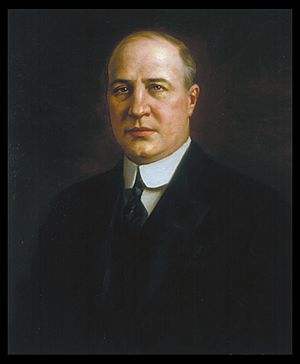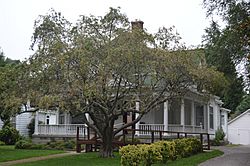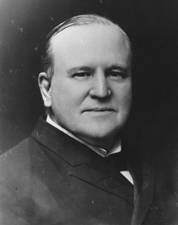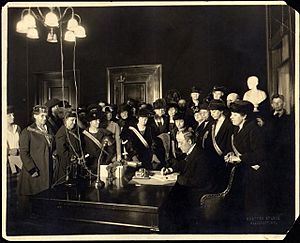Edwin P. Morrow facts for kids
Quick facts for kids
Edwin P. Morrow
|
|
|---|---|
 |
|
| 40th Governor of Kentucky | |
| In office December 9, 1919 – December 11, 1923 |
|
| Lieutenant | Thruston Ballard |
| Preceded by | James D. Black |
| Succeeded by | William J. Fields |
| U.S. District Attorney for the Eastern District of Kentucky | |
| In office 1910–1913 |
|
| Appointed by | William Howard Taft |
| Personal details | |
| Born | November 28, 1877 Somerset, Kentucky |
| Died | June 15, 1935 (aged 57) Frankfort, Kentucky |
| Resting place | Frankfort Cemetery |
| Political party | Republican |
| Spouse | Katherine Hale Waddle |
| Relations | Son of Thomas Z. Morrow Nephew of William O. Bradley |
| Alma mater | University of Cincinnati Law School |
| Profession | Lawyer |
| Signature | |
| Military service | |
| Branch/service | U.S. Army |
| Years of service | 1898–1899 |
| Rank | Second lieutenant |
| Unit | 4th Kentucky Infantry Regiment |
| Battles/wars | Spanish–American War |
Edwin Porch Morrow (November 28, 1877 – June 15, 1935) was an American politician, who served as the 40th Governor of Kentucky from 1919 to 1923. He was the only Republican elected to this office between 1907 and 1927. He championed the typical Republican causes of his day, namely equal rights for African-Americans and the use of force to quell violence. Morrow had been schooled in his party's principles by his father, Thomas Z. Morrow, who was its candidate for governor in 1883, and his uncle, William O. Bradley, who was elected governor in 1895. Both men were founding members of the Republican Party in Kentucky.
After rendering non-combat service in the Spanish–American War, Morrow graduated from the University of Cincinnati Law School in 1902 and opened his practice in Lexington, Kentucky. He was appointed U.S. District Attorney for the Eastern District of Kentucky by President William Howard Taft in 1910 and served until he was removed from office in 1913 by President Woodrow Wilson. In 1915, he ran for governor against his good friend, Augustus O. Stanley. Stanley won the election by 471 votes, making the 1915 contest the closest gubernatorial race in the state's history.
Morrow ran for governor again in 1919. His opponent, James D. Black, had ascended to the governorship earlier that year when Stanley resigned to take a seat in the U.S. Senate. Morrow encouraged voters to "Right the Wrong of 1915" and ran on a progressive platform that included women's suffrage and quelling racial violence. He charged the Democratic administration with corruption, citing specific examples, and won the general election in a landslide. With a friendly legislature in 1920, he passed much of his agenda into law including an anti-lynching law and a reorganization of state government. He won national acclaim for preventing the lynching of a black prisoner in 1920. He was not hesitant to remove local officials who did not prevent or quell mob violence. By 1922, Democrats regained control of the General Assembly, and Morrow was not able to accomplish much in the second half of his term. Following his term as governor, he served on the United States Railroad Labor Board and the Railway Mediation Board, but never again held elected office. He died of a heart attack on June 15, 1935, while living with a cousin in Frankfort.
Early life
Edwin Morrow was of Scottish descent and was born to Thomas Zanzinger and Virginia Catherine (Bradley) Morrow in Somerset, Kentucky, on November 28, 1877. He and his twin brother, Charles, were the youngest of eight children. His father was one of the founders of the Republican Party in Kentucky and an unsuccessful candidate for governor in 1883. His mother was a sister to William O'Connell Bradley, who was elected the first Republican governor of Kentucky in 1895. Morrow's great-grandfather Thomas Morrow emigrated to America from Scotland before the Revolutionary War.
Morrow's early education was in the public schools of Somerset. At age 14, he entered preparatory school at St. Mary's College near Lebanon, Kentucky. He continued there throughout 1891 and 1892. From there, he enrolled at Cumberland College (now the University of the Cumberlands) in Williamsburg, Kentucky, and distinguished himself in the debating society. He was also interested in sports, playing halfback on the football team and left field on the baseball team.
On June 24, 1898, Morrow enlisted as a private in the 4th Kentucky Infantry Regiment for service in the Spanish–American War. He was first stationed at Lexington, Kentucky, and later trained at Anniston, Alabama. Due to a bout with typhoid fever, he never saw active duty, and mustered out as a second lieutenant on February 12, 1899. In 1900, he matriculated for the fall semester at the University of Cincinnati Law School. He graduated with a Bachelor of Laws degree in 1902.
Morrow opened his practice in Lexington. He established his reputation in one of his first cases—the trial of William Moseby, a black man accused of murder. Moseby's first trial had ended in a hung jury, but because the evidence against him included a confession (which he later recanted), most observers believed he would be convicted in his second trial. Unable to find a defense lawyer for Moseby, the judge in the case turned to Morrow, who as a young lawyer was eager for work. Morrow proved that his client's testimony had been extorted; he had been told that a lynch mob waited outside the jail for him, but no such mob had ever existed. Morrow further showed that other testimony against his client was false. Moseby was acquitted September 21, 1902.
Morrow returned to Somerset in 1903. There, he married Katherine Hale Waddle on June 18, 1903. Waddle's father had studied law under Morrow's father, and Edwin and Katherine had been playmates, schoolmates, and later sweethearts. The couple had two children, Edwina Haskell in July 1904 and Charles Robert in November 1908.
Political career
In 1904, Morrow was appointed city attorney for Somerset, serving until 1908. President William Howard Taft appointed him U.S. District Attorney for the Eastern District of Kentucky in 1910. He continued in this position until he was removed from office by President Woodrow Wilson in 1913.
Morrow's first political experience was working in his uncle William O. Bradley's gubernatorial campaign in 1895. In 1899, Republican gubernatorial candidate William S. Taylor offered to make Morrow his Secretary of State in exchange for Bradley's support in the election; Bradley refused. Despite the encouragement of friends, Morrow declined to run for governor in 1911.
In 1912, Morrow was chosen as the Republican candidate for the Senate seat of Thomas Paynter. Paynter had decided not to seek re-election, and the Democrats nominated Ollie M. James of Crittenden County. The General Assembly was heavily Democratic and united behind James. On a joint ballot, James defeated Morrow by a vote of 105–28. Due to the passage of the Seventeenth Amendment the next year, this was the last time the Kentucky legislature would elect a senator.
At the state Republican convention in Lexington on June 15, 1915, Morrow was chosen as the Republican candidate for governor over Latt F. McLaughlin. His Democratic opponent was his close friend, Augustus O. Stanley. Morrow charged previous Democratic administrations with corruption and called for the election of a Republican because "You cannot clean house with a dirty broom." Both men ran on progressive platforms, and the election went in Stanley's favor by only 471 votes. Although it was the closest gubernatorial vote in the state's history, Morrow refused to challenge the results, which greatly increased his popularity. His decision was influenced by the fact that a challenge would be decided by the General Assembly, which had a Democratic majority in both houses.
Governor of Kentucky
Morrow served as a delegate to the Republican National Convention in 1916, 1920, and 1928. In 1919, he was chosen by acclamation as his party's candidate for governor. This time, his opponent was James D. Black. Black was Stanley's lieutenant governor and had ascended to the governorship in May 1919 when Stanley resigned to take a seat in the U.S. Senate.
Morrow won the general election by more than 40,000 votes. It was the largest margin of victory for a Republican gubernatorial candidate in the state's history.
Morrow was able to effect a considerable reorganization of the state government, including replacing the Board of Control with a nonpartisan Board of Charities and Corrections, centralizing highway works, and revising property taxes. He oversaw improvements to the education system, including better textbook selection and a tax on racetracks to support a minimum salary for teachers. Among Morrow's reforms that did not pass was a proposal to make the judiciary nonpartisan.
Morrow urged enforcement of state laws against carrying concealed weapons and restricted activities of the Ku Klux Klan. During his first year in office, he granted only 100 pardons. He was also an active member of the Commission on Interracial Cooperation, a society for the elimination of racial violence in the South.
Morrow was frequently mentioned as a potential candidate for vice president in 1920, but he withdrew his name from consideration, sticking to a campaign promise not to seek a higher office while governor.
In his address to the 1922 legislature, Morrow asked for $50 million for improvements to the state highway system and for the repeal of all laws denying equal rights to women. He also recommended a large bond issue to finance improvements to the state's universities, schools, prisons, and hospitals. By this time, however, the Republicans had surrendered their majority in the state House, and practically all of Morrow's proposals were voted down.
Morrow was prohibited by the state constitution from seeking a second consecutive term, and the achievements of his administration were not significant enough to ensure the election of Charles I. Dawson, his would-be Republican successor in the gubernatorial election of 1923.
Later career and death
Following his term as governor, Morrow retired to Somerset where he became active in the Watchmen of the Republic, an organization devoted to the eradication of prejudice and the promotion of tolerance. He served on the United States Railroad Labor Board from 1923 to 1926 and its successor, the Railway Mediation Board, from 1926 to 1934. He resigned to run for a seat in the U.S. House of Representatives representing the Ninth District, but lost his party's nomination to John M. Robsion.
Following his defeat in the congressional primary, Morrow made plans to return to Lexington to resume his law practice. On June 15, 1935, he died unexpectedly of a heart attack while temporarily living with a cousin in Frankfort. He is buried in Frankfort Cemetery.





